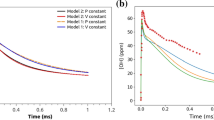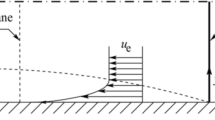Abstract
A 4-species 4-step global reaction mechanism for detonation calculations is derived from detailed chemistry through thermochemical approach. Reaction species involved in the mechanism and their corresponding molecular weight and enthalpy data are derived from the real equilibrium properties. By substituting these global species into the results of constant volume explosion and examining the evolution process of these global species under varied conditions, reaction paths and corresponding rates are summarized and formulated. The proposed mechanism is first validated to the original chemistry through calculations of the CJ detonation wave, adiabatic constant volume explosion, and the steady reaction structure after a strong shock wave. Good agreement in both reaction scales and averaged thermodynamic properties has been achieved. Two sets of reaction rates based on different detailed chemistry are then examined and applied for numerical simulations of two-dimensional cellular detonations. Preliminary results and a brief comparison between the two mechanisms are presented. The proposed global mechanism is found to be economic in computation and also competent in description of the overall characteristics of detonation wave. Though only stoichiometric acetylene–oxygen mixture is investigated in this study, the method to derive such a global reaction mechanism possesses a certain generality for premixed reactions of most lean hydrocarbon mixtures.
Similar content being viewed by others
Abbreviations
- ρ :
-
Mass density
- p :
-
Pressure
- T :
-
Temperature
- T 0 :
-
Reference temperature, T 0 = 298 K
- θ :
-
Natural logarithm of density, θ = ln ρ
- \({\xi}\) :
-
Reciprocal of temperature, \({\xi=10^3/{\rm T}}\)
- t :
-
Time
- e :
-
Total energy per unit mass
- R u :
-
Universal gas constant
- Ea:
-
Activation energy
- H :
-
Mean molar enthalpy
- H i :
-
Molar enthalpy of ith species
- W :
-
Mean molecular weight
- W i :
-
Molecular weight of ith species
- λ :
-
Mole fraction
- [X]:
-
Molar concentration of species X
- δ :
-
Stoichiometric coefficient
- s :
-
Reaction order
- K c :
-
Equilibrium constant
- k :
-
Reaction rate constant
- Ω :
-
Chemical production rate
- χ :
-
Stability parameter
References
Lutz, A.E., Kee, R.J., Miller, J.A., Dwyer, H.A., Oppenheim, A.K.: Dynamic effects of autoignition centers for hydrogen and C1,2-hydrocarbon fuels. In: 22nd Symposium (International) Combustion, pp. 1683–1693 (1988)
Miller J.A., Bowman C.T.: Mechanism and modeling of nitrogen chemistry in combustion. Prog. Energy Combust. Sci. 15, 287–338 (1989)
Konnov A.A.: Implementation of the NCN pathway of prompt-NO formation in the detailed reaction mechanism. Combust. Flame. 156, 2093–2105 (2009)
San Diego mechanism. http://web.eng.ucsd.edu/mae/groups/combustion/cermech (2006)
Petrova M.V., Williams F.A.: A small detailed chemical-kinetic mechanism for hydrocarbon combustion. Combust. Flame. 144, 526–544 (2006)
Turanyi T.: Sensitivity analysis of complex kinetic systems: tools and applications. J. Math. Chem. 5, 203–248 (1990)
Turanyi T.: Applications of sensitivity analysis to combustion chemistry. Reliab. Eng. Syst. Safe. 57, 41–48 (1997)
Massias A., Diamantis D., Mastorakos E., Goussis D.A.: An algorithm for the construction of global reduced mechanisms with CSP data. Combust. Flame. 117, 685–708 (1999)
Lu T.F., Ju Y.G., Law C.K.: Complex CSP for chemistry reduction and analysis. Combust. Flame. 126, 55–1445 (2001)
Lu T.F., Law C.K.: A directed relation graph method for mechanism reduction. Proc. Combust. Inst. 30, 1333–1341 (2005)
Pepiot-Desjardins P., Pitsch H.: An efficient error-propagation-based reduction method for large chemical kinetic mechanisms. Combust. Flame. 154, 67C81 (2008)
Bhattacharjee B., Schwer D.A.: Optimally-reduced kinetic models: reaction elimination in large-scale kinetic mechanisms. Combust. Flame. 135, 191–208 (2003)
Varatharajan B., Williams F.A.: Chemical-kinetic descriptions of high-temperature ignition and detonation of acetylene–oxygen-diluent systems. Combust. Flame. 125, 624–645 (2001)
Turanyi A., Tomlin A., Pilling M.: On the error of the quasi-steady-state approximation. J. Phys. Chem. 97, 163–172 (1993)
Lam S.H., Goussis D.A.: The CSP method for simplifying kinetics. Int. J. Chem. Kinet. 26, 46l–468 (1994)
Maas U., Pope S.B.: Simplifying chemical-kinetics intrinsic low-dimensional manifolds in composition space. Combust. Flame. 88, 239–264 (1992)
Varatharajan B., Petrova M., Williams F.A., Tangirala V.: Two-step chemical-kinetic descriptions for hydrocarbon-oxygen-diluent ignition and detonation applications. Proc. Combust. Inst. 30, 1869–1877 (2005)
Sichel M., Tonello N.A., Oran E.S., Jones D.A.: A two-step kinetics model for numerical simulation of explosions and detonations in H2–O2 mixtures. Proc. R. Soc. Lond. A 458, 49–82 (2002)
Westbrook C.K., Dryer F.L.: Chemical kinetic modeling of hydrocarbon combustion. Prog. Energy Combust. Sci. 10, 1–57 (1984)
Jones W.P., Lindstedt R.P.: Global reaction schemes for hydrocarbon combustion. Combust. Flame. 73, 233–249 (1988)
Andersen J., Rasmussen C.L., Giselsson T., Glarborg P.: Global combustion mechanisms for use in CFD modeling under oxy-fuel conditions. Energy Fuels 23, 1379–1389 (2009)
Fickett W., Jacobson J.D., Schott G.L.: Calculated pulsating one-dimensional detonations with induction-zone kinetics. AIAA J. 10, 514–516 (1972)
He L.T., Lee J.H.S.: The dynamical limit of one-dimensional detonations. Phys. Fluids. 7, 1151–1158 (1995)
Short M., Wang D.Y.: On the dynamics of pulsating detonations. Combust. Theory Model. 5, 343–352 (2001)
Daimon Y., Matsuo A.: Detailed features of one-dimensional. Detonations. Phys. Fluids. 15, 112–122 (2003)
Clavin P., He L.T.: Stability and nonlinear dynamics of one-dimensional overdriven detonations in gases. J. Fluid Mech. 306, 353–378 (1996)
Short M., Sharpe J.: Pulsating instability of detonations with a two-step chain-branching reaction model: theory and numerics. Combust. Theory Model. 7, 401–416 (2003)
Ng H.D., Radulescu M.I., Higgins A.J., Nikiforakis N., Lee J.H.S.: Numerical investigation of the instability for one-dimensional Chapman-Jouguet detonations with chain-branching kinetics. Combust. Theory Model. 9, 385–401 (2005)
Dold J.W., Kapila A.K.: Comparison between shock initiations of detonation using thermally-sensitive and chain-branching chemical models. Combust. Flame. 85, 185–194 (1991)
Short M., Quirk J.J.: On the nonlinear stability and detonability limit of a detonation wave for a model three-step chain-branching reaction. J. Fluid Mech. 339, 89–119 (1997)
Ng H.D., Lee J.H.S.: Direct initiation of detonation with a multi-step reaction scheme. J. Fluid Mech. 476, 179–211 (2003)
Liang Z., Bauwens L.: Cell structure and stability of detonations with a pressure dependent chain branching reaction rate model. Combust. Theory Model. 9, 93–112 (2005)
Liang Z., Browne S., Deiterding R., Shepherd J.E.: Detonation front structure and the competition for radicals. Proc. Combust. Inst. 31, 2445–2453 (2007)
Lu T.F., Law C.K.: Towards accommondating realistic fuel chemistry in large-scale computations. Prog. Energy Combust. Sci. 35, 192–215 (2008)
Khokhlov A.M., Oran E.S.: Numercial simulation of detonation initiation in a flame brush: the role of hot spots. Combust. Flame. 119, 400–416 (1999)
Radulescu M.I., Sharpe G.J., Law C.K., Lee J.H.S.: The hydrodynamic structure of unstable cellular detonations. J. Fluid Mech. 580, 31–81 (2007)
Radulescu M.I., Lee J.H.S.: The failure mechanism of gaseous detonations: experiments in porous wall tubes. Combust. Flame. 131, 29–46 (2002)
Zhu Y., Chao J., Lee J.H.S.: An experimental investigation of the propagation mechanism of critical deflagration waves that lead to the onset of detonation. Proc. Combust. Inst. 31, 2455–2462 (2007)
Sharpe J., Falle S.A.E.G.: One-dimensional nonlinear stability of pathological detonations. J. Fluid Mech. 414, 339–366 (2000)
Pintgen F., Eckett C.A., Austin J.M., Shepherd J.E.: Direct observations of reaction zone structure in propagating detonations. Combust. Flame. 133, 211–229 (2003)
Fickett W., Davis W.C.: Detonation. Dover Publications, New York (1979)
Kee, R.J., Rupley, F.M., Meeks, E., Miller, J.A.: CHEMKIN-III: a Fortran chemical kinetics package for the analysis of gas phase chemical and plasma kinetics. Tech. Report SAND96-8216 (1996)
Morley, C.: Gaseq: a chemical equilibrium program for Windows. http://www.c.morley.dsl.pipex.com
Schultz, E., Shepherd, J.: Validation of detailed reaction mechanisms for detonation simulation. Tech. Report FM99-5, GALCIT (2000)
Sun M., Takayama K.: Conservative smoothing on an adaptive quadrilateral grid. J. Comp. Phys. 151, 479–497 (1999)
Kaneshige, M., Shepherd, J.: Detonation database. Tech. Report FM97-8, GALCIT (1999)
Ng H.D., Botros B.B., Chao J., Yang J.M., Nikiforakis N., Lee J.H.S.: Head-on collision of a detonation with a planar shock wave. Shock Waves. 15, 341–352 (2006)
Botros B.B., Ng H.D., Zhu Y., Ju Y., Lee J.H.S.: The evolution and cellular structure of a detonation subsequent to a head-on interaction with a shock wave. Combust. Flame. 151, 573–580 (2007)
Author information
Authors and Affiliations
Corresponding author
Additional information
Communicated by S. Dorofeev.
Rights and permissions
About this article
Cite this article
Zhu, Y., Yang, J. & Sun, M. A thermochemically derived global reaction mechanism for detonation application. Shock Waves 22, 363–379 (2012). https://doi.org/10.1007/s00193-012-0375-x
Received:
Revised:
Accepted:
Published:
Issue Date:
DOI: https://doi.org/10.1007/s00193-012-0375-x




